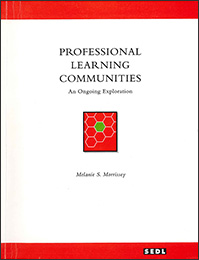Recent Literature
Benefits of Professional Learning Community

In 1997, SEDL's first effort to understand, describe, and report on professional learning communities was published (Hord, 1997). Since that time, the literature has expanded. Reyes, Scribner, and Paredes Scribner (1999) espouse the benefits of professional learning communities in their work with Hispanic schools. In these schools, which were at one time characterized as low-performing, the creation of learning communities assisted staff in overcoming the implementation problems that had accompanied past reform efforts and also increased student achievement. School staff learned to develop their own capacities in order to produce improved student outcomes from year to year, despite increasing changes in their school and surrounding communities that made teaching and learning more challenging.
Thiessen & Anderson (1999) discuss means of transforming learning communities, in which learning by teachers is connected to school improvement and improved learning for students. The authors encourage collaboration, integration, and inquiry in schools, as well as continuous engagement in actions to challenge the conditions, the relationships, the responsibility and control, and the teaching and learning that shape a school. Through such ongoing inquiry, the authors agree, schools become stronger, more productive places where teaching has improved and increases in learning are evidenced by all students.
DuFour and Eaker (1998) also highlight professional learning communities, encouraging schools to reflect on their collective capacity to address the learning needs of their students. The authors conclude that ongoing improvement efforts can succeed only when a community of colleagues supports each other through the inevitable difficulties associated with school reform.
Peter Senge, who is one of the founding fathers of the learning organization concept in the business sector (1990), has recently acknowledged the importance of learning communities in schools (2000). He recognizes schools as “a meeting ground for learning—dedicated to the idea that all those involved with it, individually and together, will be continually enhancing and expanding their awareness and capabilities” (p. 6).
Smylie and Hart (1999) emphasize that increased student learning is inextricably tied to teacher learning and collaboration, stating: “It has become increasingly clear that if we want to improve schools for student learning, we must also improve schools for the adults who work within them. . . . We have only recently come to understand that student learning also depends on the extent to which schools support the ongoing development and productive exercise of teachers’ knowledge and skills (p.421).”
In their discussion of improving the organizational capacity of schools, Newmann and Wehlage (1995) specifically identify professional learning communities as a means to that end. The researchers say that such an arrangement, identified by clear and shared purpose, collaboration, and collective responsibility for student learning, is critical to effective teaching, and has a direct effect on the improvement of student learning.
Rather than becoming a reform initiative itself, a professional learning community becomes the supporting structure for schools to continuously transform themselves through their own internal capacity. Leithwood and Louis (1998) suggest that “the task is not just to create a school organization capable of implementing the current set of reform initiatives . . . in the context of today’s turbulent environments. Rather, the task is to design an organization capable of productively responding, not only to such current initiatives in today’s environment, but to the needless number of initiatives, including new definitions of school effectiveness, that inevitably will follow” (p. 6).
Developing a Professional Learning Community
At this point, little has been written to guide schools toward professional learning community development. Rather, several researchers have written about developing aspects of the professional learning community, presenting specific strategies or tools for working with school staffs. For example, DuFour and Eaker (1998) discuss the elements and importance of the mission and vision in schools, and they walk the reader through activities that can be taken to revamp the mission and vision at their schools. Similar strategies are offered regarding the development of values and goals with school staff, but that is where the detailed examples stop.
Similarly, Wald and Castleberry (2000) offer tools and processes for developing vision, establishing staff development plans, and engaging staff in collaborative listening and learning. While useful and pertinent, the strategies they discuss are limited to particular events or situations and do not attend to the day-to-day processes for engaging staff in fully developing the five dimensions of professional learning communities.
Vision strategies are addressed also in Senge (2000), who emphasizes dialogue, reflection, and the mastery of five key disciplines (personal mastery, shared vision, mental models, team learning, and systems thinking) by school staff. Senge strongly urges readers to use their collective experiences in applying the five disciplines to the school setting, offering tools for school staffs to galvanize their learning and thus create schools that can address the issues of today by employing collective wisdom.
Next Page: An Infrastructure for School Improvement

